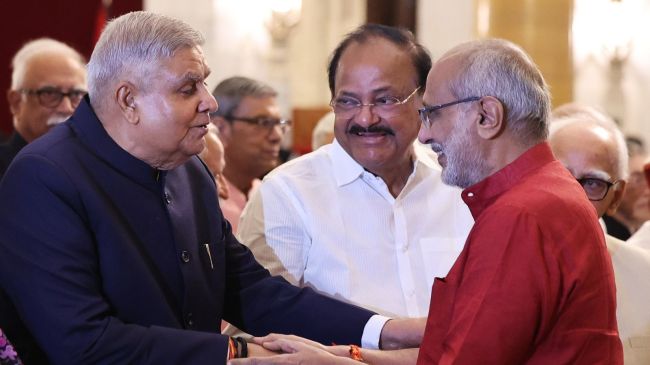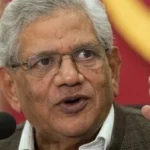C P Radhakrishnan Takes Oath as Vice President of India in New Delhi Ceremony
A Historic Moment in Indian Politics
The swearing-in of C P Radhakrishnan as the Vice President of India marks a defining moment in the nation’s political journey. Taking place in New Delhi, the oath-taking ceremony symbolized not just the transition of power, but also the continuity of India’s democratic traditions.
In a country where the Vice President also serves as the Chairperson of the Rajya Sabha, this constitutional role holds both symbolic and functional importance. Radhakrishnan’s elevation is therefore not just a personal achievement—it is a reflection of the political climate, governance vision, and institutional priorities of modern India.
Who is C P Radhakrishnan?
C P Radhakrishnan is not an unfamiliar name in Indian politics. His journey began at the grassroots level in Tamil Nadu, where he established himself as a dedicated worker of the Bharatiya Janata Party (BJP). Over decades, he built his reputation as a grounded leader, strategist, and voice for South India within national politics.
Unlike many leaders who rise through dynastic privilege, Radhakrishnan carved his place through persistence, discipline, and an ability to connect with ordinary citizens. His elevation to the Vice Presidency is a recognition of his service and a signal of India’s democratic inclusivity.
The Oath-Taking Ceremony: Symbolism and Tradition
The ceremony held in New Delhi’s Rashtrapati Bhavan was steeped in tradition and constitutional solemnity. The oath was administered by the President of India, in the presence of senior leaders, ministers, and dignitaries.
Every oath-taking in India carries weight, but the Vice President’s ceremony is special because it signals the readiness of a leader to uphold the Constitution above party lines. The Vice President is expected to rise above politics when presiding over the Rajya Sabha, ensuring fair debates and protecting the dignity of Parliament.
For C P Radhakrishnan, this was not just a ceremonial pledge—it was a promise to the people of India.
The Political Significance of His Appointment
India’s Vice President is often seen as a balancing force in the political system. At a time when Indian democracy is witnessing intense debates, polarization, and rapid transformation, the choice of Vice President becomes even more meaningful.
Radhakrishnan’s appointment carries multiple layers of significance:
- Regional Balance – His rise underscores the increasing importance of Southern India in shaping national politics.
- Parliamentary Discipline – Known for his straightforwardness, he is expected to bring decorum and order to Rajya Sabha proceedings.
- Generational Leadership – His journey represents the aspiration of leaders who rise through merit rather than dynasty.
Public Reactions and National Sentiment
The oath-taking was widely covered across television, digital platforms, and social media, reflecting the public’s keen interest. Citizens from Tamil Nadu expressed pride at seeing a leader from their state rise to the second-highest constitutional office. Political analysts called it a strategic as well as symbolic move, aligning with the government’s focus on strengthening representation from all parts of India.
For ordinary Indians, however, the event was less about politics and more about national pride. The seamless transition of office reminded citizens that India’s democracy is vibrant, resilient, and rooted in continuity.
Looking Ahead: Responsibilities and Challenges
As Vice President, Radhakrishnan faces a challenging road ahead:
- He must act as a neutral guardian of parliamentary debate.
- He will need to balance political loyalty with constitutional duty.
- His decisions in the Rajya Sabha could shape the trajectory of India’s legislative future.
The nation will watch closely how he interprets this role and whether he succeeds in becoming a bridge between government and opposition.
Early Life and Humble Beginnings
C P Radhakrishnan’s story begins far from the power corridors of Delhi. Born into a middle-class Tamil Nadu family, he grew up in an environment that emphasized education, discipline, and social responsibility.
Unlike leaders who inherit political legacies, Radhakrishnan’s rise was self-made. His formative years were marked by hard work, resilience, and a deep connection with the values of community service.
Friends and peers often describe him as a quiet but determined personality—a man who believed in perseverance rather than shortcuts. This early grounding would later define his political style: steady, principled, and people-centric.
Education and Intellectual Foundations
Radhakrishnan pursued his studies in Tamil Nadu, where he showed an early interest in economics, governance, and public administration. His education not only gave him professional grounding but also exposed him to political debates, regional aspirations, and the complexities of India’s diversity.
He was known as a voracious reader—not just of political theory but also of history and culture. This intellectual curiosity later allowed him to navigate conversations across different ideologies and regions, making him a rare bridge-builder in India’s fragmented political landscape.
Entry into Politics: The BJP Foot Soldier
In the 1980s and 1990s, when the Bharatiya Janata Party (BJP) was still finding its footing in Tamil Nadu, Radhakrishnan joined as a grassroots worker.
At that time, BJP had little presence in the state, dominated by regional parties like the DMK and AIADMK. Radhakrishnan, however, saw ideological potential in the party’s vision of nationalism combined with development.
His early political journey was not glamorous:
- Distributing pamphlets during elections.
- Mobilizing small groups of supporters.
- Organizing street-level campaigns in towns and villages.
Through persistence, he became known as a dedicated party worker who never abandoned the ground reality, even when victory seemed distant.
Rise Through Party Ranks
Radhakrishnan’s commitment and loyalty did not go unnoticed. Over the years, he rose through the BJP’s Tamil Nadu state unit, holding multiple organizational responsibilities.
His leadership style was inclusive—he believed in empowering young workers, listening to local voices, and building coalitions rather than imposing authority. This earned him both respect within the party and credibility among citizens.
When BJP began expanding its influence in southern India, Radhakrishnan became one of the faces of this growth, symbolizing the possibility of national integration without erasing regional identity.
Electoral Battles and Political Experience
Radhakrishnan contested elections in Tamil Nadu, sometimes successfully, sometimes unsuccessfully. Regardless of results, he always maintained a consistent presence in public life.
- When he won, he used his platform to raise issues of development, infrastructure, and governance.
- When he lost, he returned to the grassroots, reinforcing his reputation as a leader who did not disappear after elections.
Such persistence gave him a unique identity—a people’s politician who valued service over position.
Personal Values and Leadership Style
What set Radhakrishnan apart from many contemporaries was his approachability and humility.
- He avoided the elitism often associated with senior leaders.
- He believed in discipline, honesty, and consistency as cornerstones of leadership.
- Even as he gained recognition nationally, he never cut ties with his roots in Tamil Nadu.
Political analysts often note that his leadership is built not on rhetoric or theatrics, but on credibility and long-term trust.
The Road to National Prominence
By the 2000s, Radhakrishnan had become a well-known figure in national BJP circles. His ability to represent South Indian perspectives at the central level made him a valuable asset.
Over time, he was entrusted with parliamentary responsibilities, organizational tasks, and policy discussions. His steady hand and lack of controversy distinguished him in an era of volatile politics.
This combination of grassroots connection and national recognition eventually positioned him as a consensus candidate for higher constitutional office.
The Vice President of India occupies the second-highest constitutional office in the country. Unlike other positions that are politically dynamic, the Vice Presidency is rooted in stability and institutional balance.
Key responsibilities include:
- Serving as the ex-officio Chairperson of the Rajya Sabha (Upper House of Parliament).
- Presiding over debates with neutrality and discipline.
- Stepping in as acting President if required.
This makes the Vice President not just a ceremonial figure, but a guardian of parliamentary dignity and continuity.
A Historical Overview: Vice Presidents of India
Since independence, India has had a series of Vice Presidents who played pivotal roles in shaping parliamentary democracy.
- Dr. S. Radhakrishnan (1952–1962)
- A philosopher-scholar and India’s first Vice President.
- Elevated the dignity of the office with his intellectual depth.
- Dr. Zakir Husain (1962–1967)
- Later became President of India.
- Stressed inclusivity and educational reforms.
- B. D. Jatti, G. S. Pathak, and others (1960s–70s)
- Focused on maintaining balance during politically turbulent times.
- R. Venkataraman (1984–1987)
- Served as Vice President before becoming President.
- Played a stabilizing role during coalition politics.
- Krishan Kant, Bhairon Singh Shekhawat, Hamid Ansari, Venkaiah Naidu
- Each represented a different political era, balancing partisanship with parliamentary responsibility.
- Jagdeep Dhankhar (2022–2025)
- Brought a more assertive style to the role, often clashing with the Opposition.
The continuity of diverse Vice Presidents reflects the adaptability of the office to India’s shifting political landscape.
How C P Radhakrishnan Fits into This Legacy
C P Radhakrishnan enters this line of Vice Presidents with a unique combination of grassroots credibility and national experience.
- Regional Voice: Unlike many predecessors from North India, he represents the aspirations of Southern India.
- Non-Dynastic Leader: His rise is a testament to meritocracy rather than family legacy.
- Bridge Builder: Known for patience and humility, he may bring a softer yet effective style of leadership compared to more combative predecessors.
Analysts believe his tenure could be marked by restoring decorum in Rajya Sabha debates, something much needed in today’s polarized climate.
The Rajya Sabha Challenge
The Rajya Sabha, or Council of States, has historically been a forum for deep debate and reflective lawmaking. However, in recent years, it has often been disrupted by walkouts, protests, and verbal clashes.
As Chairperson, Radhakrishnan will need to:
- Balance neutrality and firmness while presiding over debates.
- Ensure both ruling and opposition voices get fair opportunities.
- Prevent the chamber from descending into chaotic disruptions.
His challenge is not just procedural but political, since parliamentary decorum reflects the health of Indian democracy.
Comparisons with Past Vice Presidents
- S. Radhakrishnan vs. C P Radhakrishnan: While the first Vice President was a scholar-statesman, the current VP is a grassroots politician. Both, however, share a commitment to principled conduct.
- Hamid Ansari vs. C P Radhakrishnan: Ansari emphasized diplomacy and intellectual discourse, while Radhakrishnan may prioritize regional inclusivity and development debates.
- Venkaiah Naidu vs. C P Radhakrishnan: Naidu was known for witty one-liners and assertive control; Radhakrishnan is likely to bring a calmer, consensus-driven style.
Thus, every Vice President leaves a unique imprint, and Radhakrishnan’s imprint will be shaped by his South Indian roots and BJP background.
Symbolism of the Oath Ceremony
Oath-taking is not just a legal procedure—it carries symbolic weight. When C P Radhakrishnan placed his hand on the Constitution and took the pledge, it was seen as:
- A commitment to impartiality, rising above party loyalty.
- A signal of India’s federal inclusivity, as voices from Tamil Nadu gain greater national representation.
- A reminder of democratic continuity, even as governments and parties change.
This symbolism resonates deeply with citizens who see the Vice Presidency as a moral compass within the political system.
The Vice Presidency has historically been a pillar of India’s democracy—a stabilizing force, a guardian of parliamentary dignity, and at times, a bridge between turbulent political waters.
As C P Radhakrishnan steps into this office, he carries the weight of this legacy. His challenge will be to uphold tradition while navigating the polarized politics of today.
India’s Current Political Climate: Polarization and Tensions
Indian politics today is marked by deep polarization. The ruling Bharatiya Janata Party (BJP) commands a strong presence in the Lok Sabha (Lower House), but the Rajya Sabha balance is often more complex. Opposition parties, including the Congress, regional outfits like DMK, Trinamool Congress, AAP, and Left parties, frequently challenge and resist government policies.
This polarization has often led to:
- Disruptions in parliamentary proceedings.
- Lack of consensus on major bills.
- A growing perception of confrontation rather than constructive debate.
In this environment, the Vice President, as the Chairman of the Rajya Sabha, becomes a critical figure who can mediate, balance, and restore dignity to the House.
The Rajya Sabha: Arena of Political Clashes
The Rajya Sabha was originally envisioned as the “House of Elders”—a space for thoughtful, measured discussion. However, in recent years, it has often been seen as an arena of political battles.
Examples include:
- Walkouts during debates on farm laws.
- Protests over inflation, unemployment, and foreign policy.
- Heated exchanges between government ministers and opposition leaders.
The challenge for C P Radhakrishnan will be to manage this turbulence without appearing biased toward the ruling party, despite his long-standing association with the BJP.
Radhakrishnan’s Balancing Act
Analysts expect his approach to be less combative and more conciliatory compared to his predecessor Jagdeep Dhankhar. Radhakrishnan is known for his calm temperament and humble style, which may help him in handling sharp political clashes.
His strategy will likely involve:
- Firm but Neutral Moderation – Ensuring debates remain within parliamentary rules.
- Encouraging Dialogue – Promoting issue-based discussions rather than sloganeering.
- Respecting Federalism – Giving adequate voice to regional parties, especially since he represents Tamil Nadu’s political diversity.
Key Issues Awaiting Rajya Sabha Debate
As Radhakrishnan begins his tenure, several crucial issues are expected to dominate parliamentary discussions:
- Economic Reforms: Taxation, investment, job creation.
- Social Justice and Welfare Schemes: Reservation policies, education reforms, healthcare programs.
- Foreign Policy Challenges: India’s role in global conflicts, trade wars, and diplomacy with neighboring countries.
- Digital Regulation: Policies on social media, AI, and cyber security.
- Environmental Laws: Climate change mitigation, sustainable energy transitions.
His ability to steer debates constructively will decide whether the Rajya Sabha emerges as a meaningful forum or remains a stage for political showdowns.
Government vs. Opposition: A Delicate Relationship
The BJP-led NDA government may expect smoother coordination given Radhakrishnan’s party background. However, he will be watched closely by opposition parties who will judge his neutrality.
- If he leans heavily towards the government, it could erode the credibility of his chairmanship.
- If he maintains fairness, he may emerge as a respected parliamentary figure even among rivals.
This delicate balance will define his political legacy as Vice President.
Symbolism for Southern India
Radhakrishnan’s appointment also carries strong regional symbolism.
- For Tamil Nadu, it is recognition of South India’s role in national leadership.
- For the BJP, which has struggled in the South, it is an opportunity to strengthen its presence by highlighting leaders from the region.
This regional dimension will also shape how he is perceived—not just as the Vice President of India, but also as a bridge between North and South political narratives.
Public Expectations
Citizens often see the Vice President as a figure who must rise above partisan politics. With growing public frustration over frequent disruptions in Parliament, people expect Radhakrishnan to:
- Protect the dignity of the Rajya Sabha.
- Ensure debates focus on real issues affecting citizens.
- Demonstrate that Indian democracy can thrive through dialogue rather than division.
His oath is not just a constitutional requirement but also a public trust placed upon him.
C P Radhakrishnan’s oath as Vice President marks not only a personal milestone but also a critical moment for Indian democracy. As the Chair of the Rajya Sabha, his leadership will be tested in the crucible of political polarization, government-opposition confrontations, and the demand for constructive parliamentary debate.
If he can strike the right balance—firm, fair, and inclusive—his tenure could set a new benchmark for the Vice Presidency.








